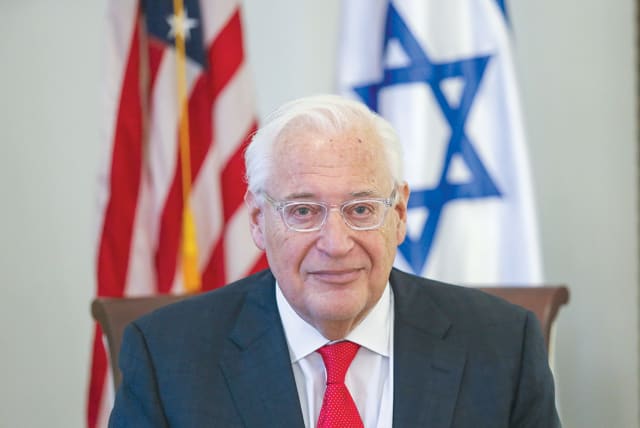Grapevine: 'Hakafot shniyot'

Movers and shakers in Israeli society.

It sounded like a mutual admiration society as former US ambassador David Friedman and Jerusalem Mayor Moshe Lion heaped compliments on each other.
The occasion was the Second Hakafot, which returned to Liberty Bell Park after a nine-year hiatus.
For some 30 years, according to Friedman, the Second Hakafot were sponsored by Eugen Gluck and his wife, Jean, Holocaust survivors who became extremely affluent in the US, and happily shared their wealth with Shaare Zedek Medical Center, Magen David Adom, Yad Vashem, the Jerusalem Great Synagogue, and, most of all, the Beit El community in the West Bank. When politician Ya’akov Katz, popularly known as “Ketzele,” set up a media center in Beit El, beginning with Arutz Sheva, Eugen Gluck was its chief funder.
Gluck was also president of the American Friends of Beit El, and every Sukkot, Friedman recalled, he would take busloads of tourists to Beit El for simchat beit hasho’eva and Hoshana Raba.
As for Lion, Friedman listed several improvements in Jerusalem that have evolved during the mayor’s tenure.

He concluded his remarks by saying that no people is more resilient than the people of Israel, and no people will survive like the Jewish people.
Lion, for his part, underscored the historic role played by Friedman in moving the US Embassy to Jerusalem. He called Friedman “a true David of Jerusalem” and noted that he had not only enhanced relations between Israel and the United States but also between Israel and the whole Jewish world.
The event, held in English and Hebrew, was almost canceled at the last moment due to an electricity problem. Fire authorities wanted to close it down, but in the end the problem was solved. But early birds had to wait behind a barrier because repairing the problem took time, and resulted in a 45-minute delay.
There was quite a large crowd, which included rabbis, soldiers, families of hostages, and residents of Beit El. Helping out with the organizing were the Jerusalem Municipality, Bnei Akiva, the hesder (military plus yeshiva ) program run by Herzog College, and the Great Synagogue.
Sponsors were Rosie and Dr. Mark Friedman, Sidney and Cheryl Gluck, and Barbara and Alan Weichselbaum. The latter, who is the son-in-law of Eugen Gluck, who died in 2019, said that Gluck’s children had decided to revive the annual hakafot in Gluck’s memory, but that this year they were dedicated to the victims and heroes of Oct. 7, the hostages, and the soldiers of the IDF. Weichselbaum, like Lion, had only superlatives for Friedman, and said that he is part of the extended Gluck family.
(Also before becoming ambassador, Friedman was a strong supporter of Beit El.)
While the turnout was quite large, it was nowhere the size that it had been in the heyday of the Second Hakafot, but then life had been more or less normal, without the suspension of flights to Israel and, more important, without a war, so there had been hordes of tourists.
The first round of hakafot was led by Friedman, and included Malcolm Hoenlein and Zalli Jaffe, president and vice president, respectively, of the Great Synagogue.
Interestingly, a circle of religious girls dancing with great enthusiasm was much larger than any of the male circles, and kept growing as more girls and women joined in. The essential gender difference was that the men carried Torah scrolls, but this honor was denied to the women.
There are lots of specific gender divisions in the Orthodox stream of Judaism, but the Torah should not be one of them. First of all, women were present when the Torah was initially given at Mount Sinai. Secondly, the Torah is known as the Bride of the Jewish People. At Orthodox Jewish weddings, all the female guests dance with the bride. Why are they not permitted to dance with “the bride” on Simchat Torah or the Second Hakafot? It seems illogical, and one doesn’t have to be a feminist to make that argument. In the history of the Jewish people, many things that were denied to women as little as a century ago are now commonplace, especially in the field of intensive Jewish studies. There are female scholars who surpass most rabbis. Why is there still a prohibition on women dancing with the Torah?
Herzog meets teenagers
■ TEENAGERS WHO met last week with President Isaac Herzog and his wife, Michal, asked him whether he had dreamed of being president when he was a boy. The question may have derived from the fact that the president’s father, Chaim Herzog, had been Israel’s sixth president, while the current president is the 11th. Herzog replied that the presidency is not hereditary, so he had not dreamed or imagined that he would one day occupy this position. But he had known since boyhood that he wanted to engage in public life.
Indeed, most of his adult life has been in public service as a cabinet secretary, member of Knesset, government minister, leader of the Labor Party, opposition leader, and chairman of the Jewish Agency. During the Gulf War, he was recruited as one of the public speakers for Israel and got very little sleep, as he went around the country addressing solidarity missions from abroad and giving interviews to the foreign media.
Nearly all the teenagers who were invited to the President’s Residence were evacuees from all over the country, with a large ratio from both the North and the South, temporarily living in Jerusalem.
greerfc@gmail.com
